‘This bloody and accursed Empire’
Published in Features, Issue 6 (November/December 2020), Volume 28Hugh Mahon, the Irishman expelled from the Australian parliament.
By Jeff Kildea
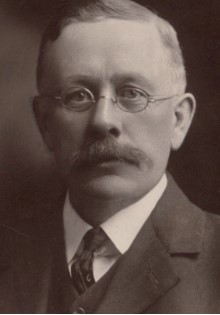
Above: Hugh Mahon in 1908. (National Library of Australia)
As we progress through the ‘decade of centenaries’, many are likely to be suffering from centenary fatigue. No doubt our forebears 100 years ago felt a similar fatigue but with more justification. For them the decade had begun optimistically with the introduction of the Third Home Rule Bill in April 1912, but anticipation soon led to despondency, as war, disappointment and civil violence followed in quick succession. Arguably, 1920 was the decade’s low point for the hopes of the Irish people to attain the right to self-determination for which they had patiently struggled peacefully and then forcefully for more than 40 years. Such gloom was not confined to the Irish in Ireland, for Ireland’s struggle was also being waged vicariously throughout the British Empire, wherever the Irish were in significant numbers.
This was particularly so in Australia, where those of Irish birth or descent accounted for about a quarter of the population. While the struggle in Australia was not fought with guns, it was nevertheless conducted with high passion, as Australians of British (mostly Protestant) and Irish (mostly Catholic) backgrounds engaged in bitter rhetorical conflict. Those interested in commemorating the events of a century ago might care to mark their calendars for 11 November, for on that date 100 years ago the Australian prime minister, William Morris (‘Billy’) Hughes, proposed in the House of Representatives a motion for the expulsion from the Australian federal parliament of Hugh Mahon, the Irish-born Labor member for Kalgoorlie in Western Australia. After fourteen hours of debate, the House passed the motion on party lines, thus conferring on Mahon the odious distinction of being the only member of the Australian parliament ever to have been expelled.
So, what heinous crime had Mahon committed that warranted such a drastic and unique penalty? In short, it was Mahon’s caustic criticism of British rule in Ireland at a public meeting to protest against the death on hunger strike of Terence MacSwiney, the Sinn Féin lord mayor of Cork.
Mahon’s background
Born in 1857 at Killurin, near Tullamore, Co. Offaly, Mahon emigrated to North America with his family in 1869. They first settled in Ontario and later in Albany in upstate New York, at the time the most Irish city in the United States. Their American dream failed, however, and in 1880 the Mahons were back in Ireland. Having learned the newspaper business in America, Mahon took up a position as manager and editor of the New Ross Standard and as a reporter for the Wexford People, both nationalist newspapers owned by Edward Walsh.
With a nationalist fervour acquired in America, Mahon took a leading role in the Land League, using his press to print leaflets urging the people to boycott recalcitrant landlords. Soon he came to the attention of the authorities, and in October 1881 he was arrested and imprisoned under coercion legislation, serving time in Kilmainham Gaol with Parnell. Released from prison on health grounds, he immediately returned to his Land League activities, but on being warned that he was about to be re-arrested he left Ireland for Australia.
In his new country he was employed by the local chapter of the Land League (later the Irish National League) to promote the tenants’ rights cause among the Australian Irish and to raise funds to send home. When John and William Redmond visited Australia in 1883 on a ten-month fund-raising tour, Mahon was one of the principal organisers, escorting them around the country. After the Redmond brothers left for America, Mahon returned to journalism, at first in New South Wales and Victoria and then in Western Australia.
Mahon’s move to Western Australia came in the wake of the discovery of gold there in the early 1890s. Miners on the goldfields were hungry for news and Mahon set up newspapers in mining centres. He became involved in local politics and gained a reputation as a crusading journalist, exposing corruption in business and government.
Commonwealth of Australia
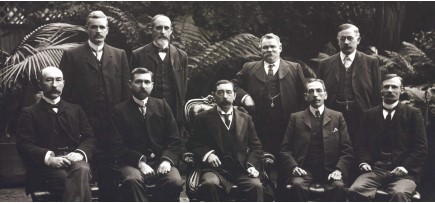
Above: The Watson Labor government, 1904, with Mahon standing on the right. Mahon would serve in four Labor ministries, including as Minister for External Affairs during the First World War. Sixteen years later, Billy Hughes (sitting, second from right) as prime minister, having by then defected to the conservative Liberal Party, would propose the motion for Mahon’s expulsion from parliament. (National Library of Australia)
In 1901 the six Australian colonies federated to become the Commonwealth of Australia; Mahon was elected to the new federal parliament as the Labor Party’s candidate for the seat of Coolgardie, which was centred on the mining districts. He held that seat until its abolition in 1913 and then became the member for another goldfields seat, Kalgoorlie. During his political career Mahon would serve in four Labor ministries, including as Minister for External Affairs during the First World War.
When William Redmond returned to Australia in 1904, he asked Mahon to shepherd through the Australian parliament a resolution in support of Home Rule for Ireland. When the Redmonds had left Australia 21 years before, Mahon had concentrated on Australian issues, ceasing his involvement in Irish nationalist affairs, but the passage of the Home Rule resolution in 1905 marked the beginning of his return to prominence as an Australian Irish nationalist.
‘Deep regret at rebellious outbreak in Dublin’
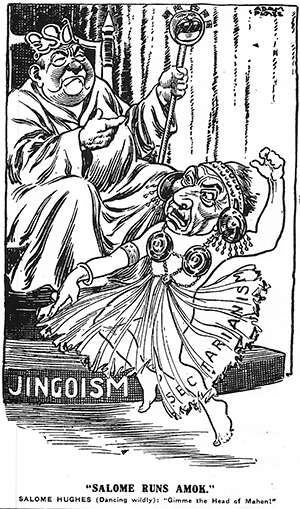
Above: ‘Salome’ Hughes in the House of Representatives demanding Mahon’s head. (Australian Worker, 18 November 1920)
Like most Irish Australians, Mahon was a Home Ruler and a supporter of the Irish Parliamentary Party. Like many of his compatriots, however, he would become radicalised by events in Ireland following the 1916 Easter Rising. When news of the outbreak of violence in Dublin first reached Australia, the local Irish initially deplored the Rising and criticised its leaders as misguided. As Minister for External Affairs, Mahon drafted a cable to the British government expressing the Australian government’s ‘deep regret at rebellious outbreak in Dublin’, but after the executions of the leaders and the imposition of martial law the Australian Irish began to criticise British misrule. This resulted in a backlash from the British Protestant majority.
Sectarianism had been endemic in Australia since the founding of the colony at Sydney in 1788, with ethno-religious conflicts from the old world being transplanted to the new. For the most part it simmered beneath the surface, occasionally rising to the boil, as when shots were fired in Melbourne during a Twelfth of July parade in 1846 and rioting broke out in Sydney on St Patrick’s Day 1878. In the years before the war, tensions began to rise when Catholics began a political campaign for government funding for their schools. This was coupled with intense local interest in the debate over the Asquith government’s intention to legislate for Irish Home Rule. The outbreak of war acted as a circuit-breaker, with Catholics and Protestants coming together in the recruiting halls to enlist in the Australian Imperial Force. For the next twenty months, until April 1916, the fragile truce remained in place, but, as in Ireland, all changed utterly following the Rising.
Conscription referendums
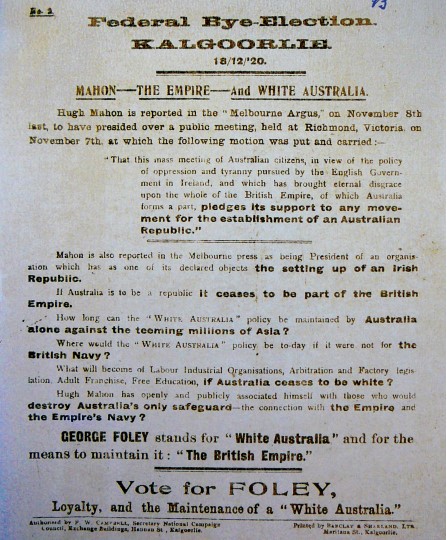
Above: ‘Loyalty, and the Maintenance of a “White Australia”’—election leaflet of George Foley, who defeated Mahon in the Kalgoorlie by-election of 18 December 1920. (Mahon Papers)
The situation worsened when Prime Minister Billy Hughes sought to introduce conscription. He knew that his own Labor Party would not agree to it, so he went over their heads to the people with a referendum. The ploy failed, as the Australian people in October 1916 rejected conscription. A second referendum in December 1917 also failed. Hughes and other pro-conscriptionists laid the blame on Australia’s Irish Catholics, who were led by Irish-born Archbishop Daniel Mannix of Melbourne, who frequently clashed publicly with Hughes.
Hughes split with the Labor Party and joined forces with the conservative Liberal Party to form a new Nationalist government that became known as the ‘Win-the-War Party’. Mahon, who had served in Labor ministries with Hughes, broke with his friend over conscription and chose to stay with the Labor Party. At the ‘khaki election’ of May 1917 he lost his seat but regained it at the following election in 1919.
While out of parliament, Mahon increasingly involved himself in Irish nationalist affairs. By 1919 he had become president of the Irish-Ireland League of Victoria, a pro-Sinn Féin organisation. His shift from Home Ruler to Sinn Féin supporter had been gradual. Many other Irish Australians made a similar journey, urged on by Archbishop Mannix, who had become increasingly outspoken in support of Ireland’s struggle for self-government. Addressing a meeting of 100,000 at Richmond Racecourse in November 1917, Mannix told his audience that Sinn Féin was determined that Ireland would no longer be governed in the interests of England and the Empire but in the interests of Ireland, with the Empire second. He gave that idea an Australian flavour by declaring, ‘You in Australia are Sinn Féiners and more luck to you. To you Australia is first and the Empire second.’
Sectarian warriors
After the armistice, the sectarian war in Australia continued, fanned largely by events in Ireland. Press reports of atrocities were seized upon by sectarian warriors on one side or the other in the local conflict to berate their opponents. It was in this context that Hugh Mahon found himself facing a motion by the prime minister to expel him from the House.
Following MacSwiney’s demise, Mahon had attempted to have the situation in Ireland debated in the parliament. Heckled by government members, his motion was summarily dismissed. Two days later Mahon took the opportunity to make his point at a meeting in Melbourne called by the Irish-Ireland League to protest MacSwiney’s death. In his speech he attacked the British government for letting ‘scoundrels’ and ‘ruffians’ loose in Ireland ‘to establish a reign of terror’, telling his audience that Cromwell was ‘a decent man compared with Lloyd George’. Referring to MacSwiney, he said:
‘Never in Russia under the worst [rule] of the Czars had there been such an infamous murder as that of the late Alderman McSwiney. They were told in the papers that Alderman McSwiney’s poor widow sobbed over his coffin. If there was a just God in heaven that sob would reach round the world, and one day would shake the foundations of this bloody and accursed Empire.’
A report the next day in Melbourne’s Argus newspaper led to an immediate outcry from Protestant, loyalist and ex-service organisations across the country. Mahon’s outburst had occurred on 7 November 1920, just four days before the second anniversary of the end of the war in which 60,000 Australians had died fighting for ‘this bloody and accursed Empire’. The nation was still in deep mourning for the loss of so many of its young men, and Empire loyalism among the British Protestant majority was at its height.
Hughes saw the opportunity to get back at his erstwhile colleague for deserting him over conscription in 1916. He was also keen to win Mahon’s seat from the Labor Party, for his government was one seat short of a majority and was clinging to power with the support of the newly formed Country Party, which owed him no allegiance. Faced with a rising wave of public opinion demanding action against Mahon, Hughes readily obliged.
Once the motion passed the House and Mahon’s seat was declared vacant, the government announced a by-election for 18 December 1920. Mahon recontested the seat but was defeated by George Foley, who campaigned on the issue of Empire loyalty.
Irish Race Congress
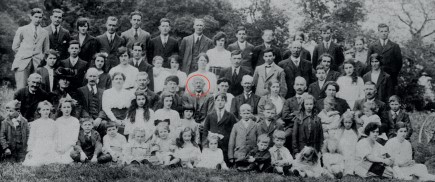
Above: Hugh Mahon (circled) at a Mahon family gathering at Charleville Castle, Co. Offaly, during his visit to Ireland in 1922. (Ken Mahon)
Once more Mahon was out of parliament. This time he devoted himself to managing the Catholic Church Property Insurance Co., which he had founded in 1912 on the model of the equivalent body in Ireland. Nevertheless, he was not finished with the politics of Ireland. In 1921 he was appointed Victoria’s representative to the Irish Race Congress to be held in Paris in January 1922. On his way there, however, he fell ill at Marseilles and was hospitalised for three months, suffering from the chronic lung disorder that had led to his release from Kilmainham 40 years before. This was doubly unfortunate, as his reputation as a once-imprisoned Irish patriot and his skills as a politician might have helped to reconcile the pro- and anti-treaty factions attempting to co-opt the congress’s support in the dispute.
After leaving hospital he visited Rome, where he attended an audience with the new pope, Pius XI. He then returned to Ireland for the first time since his emigration to Australia. Although Mahon had supported Sinn Féin’s call for independence during the recent troubles, like most Australians he believed that the treaty, by conferring on Ireland the same dominion status enjoyed by Australia, had delivered it. He said as much in a newspaper interview published in the Irish Independent and the Freeman’s Journal. Unwisely, in the interview he criticised the Irish Labour Party for not getting with the programme, leading to a rebuke from the Voice of Labour for his impertinence in criticising the party ‘of which he knows nothing’ in the ‘anti-Labour Press’.
After attending a family reunion, Mahon returned to Australia, where he continued to manage the insurance company until his death in August 1931. When a condolence motion was moved in the House of Representatives, one member, who had lost a leg during the First World War, broke with the tradition of not speaking ill of the dead and dissociated himself from the motion on the basis that Mahon ‘ultimately fell foul of Australian sentiment’. More than a decade on, Mahon’s attack on ‘this bloody and accursed Empire’ still rankled.
Jeff Kildea is an Adjunct Professor of Irish Studies at the University of New South Wales.
FURTHER READING
J. Beaumont, Broken nation: Australians in the Great War (Sydney, 2013).
M. Hogan, The sectarian strand: religion in Australian history (Melbourne, 1987).
J. Kildea, Hugh Mahon: patriot, pressman, politician (2 vols) (Melbourne, 2017 & 2020).
P. O’Farrell, The Irish in Australia (Kensington, NSW, 1993).
















